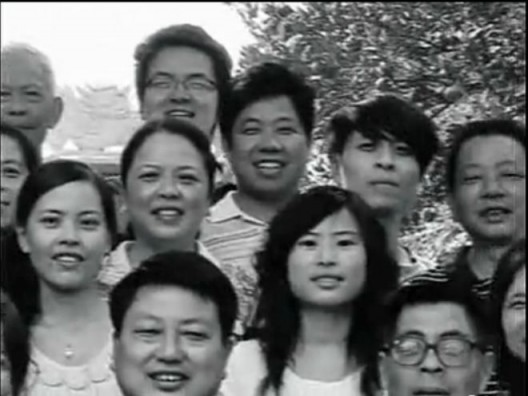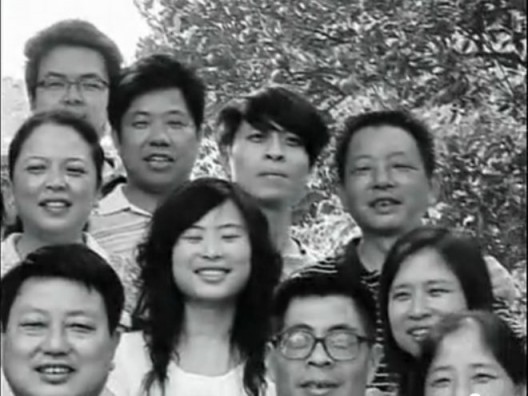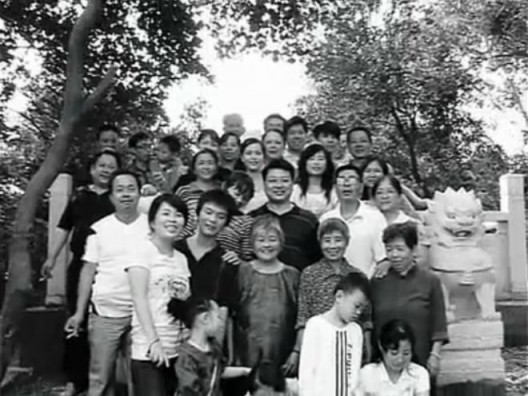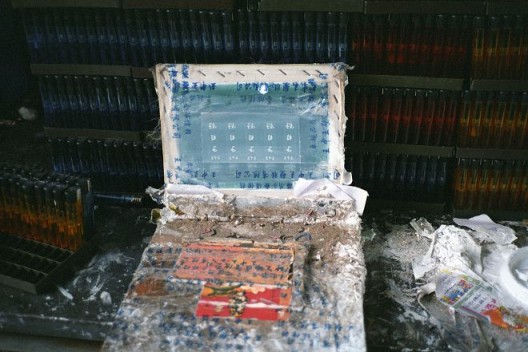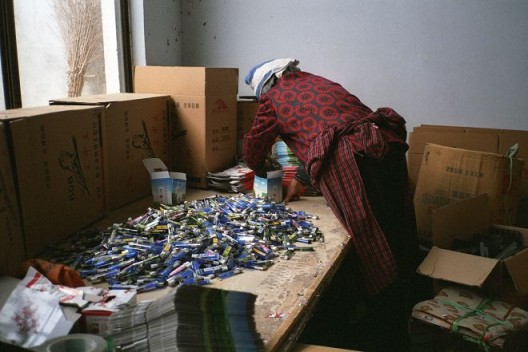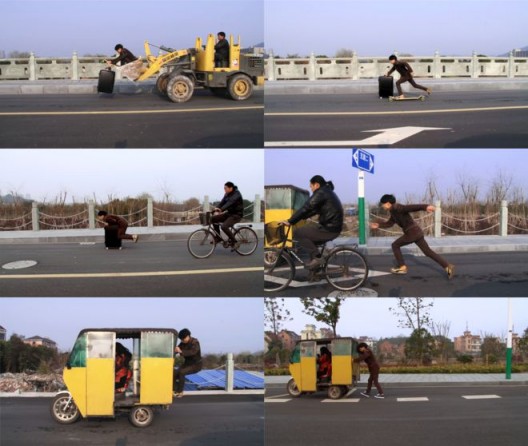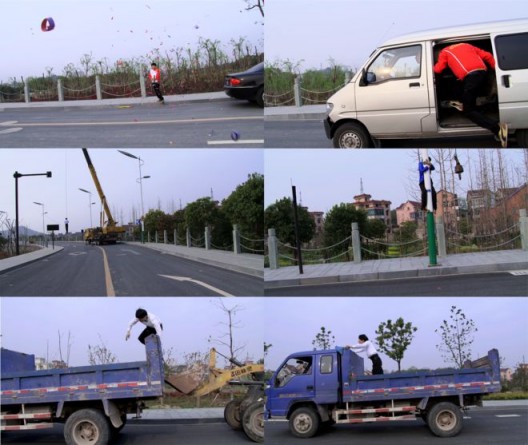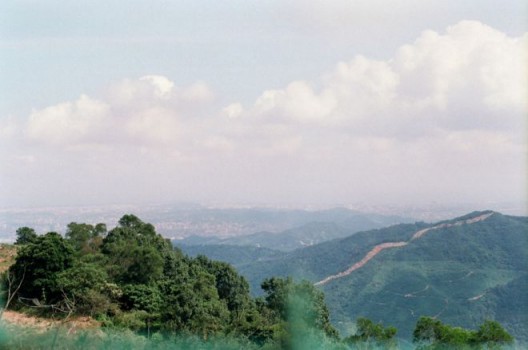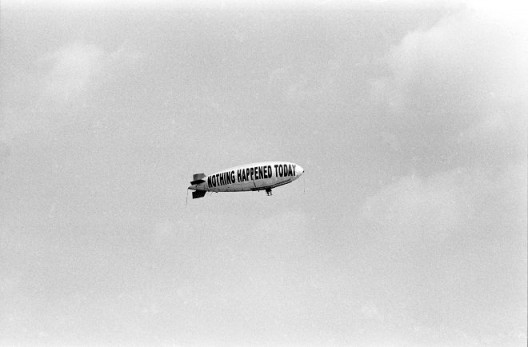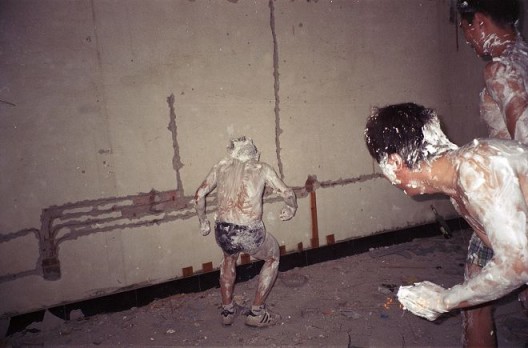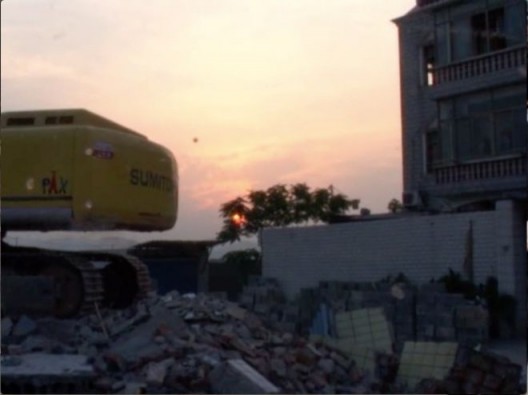This piece is included in Ran Dian’s print magazine, issue 3 (Spring 2016). An accompanying interview will also be online shortly.
I have always acknowledged that the impulse to fight against boredom is one of the most honest sources of art making. Remarkably, the art born of this attempt is full of idle moments—apparently uninteresting or irrelevant, but reminding us that it is precisely these that constitute life.
To make “Visiting Ancestral Graves (Family Portrait)” (2009), Li Ming filmed the members of his family during a visit to the graves of their ancestors. The video is made of scattered (inter)actions and situations filmed in black and white, mimicking the style of old films in order to celebrate (yet at the same time desecrate) a thousand-year-old ritual rooted in Chinese civilization. It culminates with a sequence of the family reunited before Li’s camera: in between, a sudden blast of gunshots (taken from an anti-Japanese war movie) counterpoints in a somewhat tragicomic way the images of his relatives igniting firecrackers.
Through the eyes of the artist and through the lens of his video camera, the solemn circumstance becomes a kind of slapstick. The reason this can happen, however, is precisely the very special position it holds inside the culture to which it belongs. This explains the peculiar way Li Ming decodes the reality surrounding him: thorough research across the layers of meaning of daily life and its more-or-less plain circumstances. In addition, the work succeeds in showing the uncomfortable position Li occupies here (perhaps similar to the one artists occupy within an enlarged society?). This is revealed by his puzzled-yet-amused expression in the final shot: participating as “one of the family,” he is also, fatally, a detached observer—almost an intruder. Just as Jean Epstein, in his 1924 study “On Certain Characteristics of Photogénie”, advocates for the capacity of cinema to make viewers see the world afresh, so in Li’s videos—the main medium he uses alongside his own body—we are prompted toward and pushed inside a world that has lost sense, or never had any in the first place, and urged to find a new meaning that can be validated by Li Ming and the audience. By depriving moments of their preconfigured grand rhetoric, Li enhances their non-explicit significance inasmuch as it is updated to the contemporariness and its imperatives (the way things are supposed to look, or simply be, now) and psychic modalities (the way people are supposed to interact and react to those things, now). His work derives from an uncomfortable, though always ironic, quest for sense that is both historical (i.e., political) and human (i.e., psychological). As is often the case, only nonsense can help this enterprise.
Li Ming is a sophisticated type of contemporary flâneur. He takes possession of the space that is in turn defined by a human presence (i.e., by the bodily-physical presence of an aware human being), roaming in it and throughout it. He enjoys chasing spaces, but also words and concepts.
Just like words, numbers are important in his work. They define plural versus singular but are also eerily dynamic—propellers of the transformative process that life is. We count money as we count years (ours) and objects (the ones produced and the ones possessed). Numbers of cells, strands of hair, individual socks—numbers have a frightful power, but they release us from the shackles of meaning. Things find their meanings in numbers. Numbers lead to sequences, repetition—and repetition leads to accumulation. Li is aware of what defines contemporary life as such, and this is what makes his work so poignantly modern, in the sense of the actual, but also what is instinctively traditional, that is, relying on a certain knowledge that derives from the pondering of phenomena.
Millions of disposable lighters are manipulated every day by an endless number of hands producing a habitual gesture. Li Ming is fascinated by the invisible life of these trivial objects (“It’s hard to believe we can fit so many great ideas into something so thin,” he and his friend Chen Zhou wonder) coming from the Xiayi County in Shangqiu City, Henan Province, the largest lighter production base in China. There, they are touched by unknown, anonymous hands before reaching ours—an invisible thread connecting us to a labor force that is to varying degrees alienated from us. So in the 2014 work “Disposable Lighters”, he inserted himself into this cycle of production and consumption, intercepting a large quantity of lighters. Departing from the factory premises and spaces of production, the artist arrives at a space of representation. The power of common objects conveys a sense of reassuring connection with certain immutable laws, and when they are detached from their use value, through them we can regain a sense of wonder toward the human endeavor—what some call progress, or just a sign of the times. Li calls this residual wonder of humans toward humans zhìhuì, typically translated as “wisdom,” but as the Chinese character indicates, also a combination of knowledge and intelligence.
Intentional repetition and seriality, used by Li Ming to mock automatic accumulation, can lead to a form of enlightenment. So it happens in “Movements” (2014), in which the artist is seen in perpetual motion: running, skating, sliding on a trolley, chasing lifts from bicycles, trucks, excavators, tuk-tuks. The work presents juxtaposed video channels conveying a deceptive impression of linearity (what looks like one single, long take screened on different channels with a slight time lapse is actually entirely different shots), revealing at the same time the trickery behind the formation of any image. In fact, Li proves here that the way we interpret images is heavily conditioned by our preformed visual habits—the conventions of television and films, in particular the traditional montage technique as established in the classic Hollywood era and even earlier.
The exploration of bodily movement through the artificial movement of film is pushed further in two other works made in 2014: “Zoom” and “Straight Line, Landscape”, where his movement during the two journeys made from one place (Hangzhou) to another (Shanghai in the former and Taiwan in the latter) is intertwined with the function of two devices: the camera zoom and the GPS. The electronic devices become extensions of the body, and the artist’s body an extension of the devices. Functions are thus reconsidered (so is the power attached to them), and in turn they are reinforced with a new legitimacy to be found in the free movement of the body-mind, and the consequent liberation from the constraints of repeated action within an urban or urbanized environment.
Li’s intuition goes beyond the clichés of a liberated “natural” body, because, as demonstrated in “Landscape”, there is no bigger artifice than “nature” itself—at least as defined and manipulated in different narratives—in particular mountains and mountainous landscapes, which are depicted here as the myth of a self-renewing bourgeoisie in search of quick catharsis. As Miriam Bratu Hansen perceptively stressed via Siegfried Kracauer, “Les Alpes”—or, better, the myth of the mountains as a timeless Arcadian shelter from the stress of modern life—have been used (eminently in film) in a reflexive way, as a counterpoint to historically located urban sceneries. By the same token they have also become reified symbols—a “mass ornament,” to quote the title of the well-known “Weimer essays” by the German philosopher.1 The use of nature-as-concept for the sake of a human-made world is also effectively explored in “The Color of Pomegranate” (2007), where the artist is seen painting sick-looking pomegranates hanging on a tree to make them look redder and juicier. The three videos in the series Nature (2011) also explore the aberrations of disciplined, or, worse yet, simulated natural phenomena.
Li Ming’s peculiar understanding of space involves his own presence in it and the decoding of it. He decodes its historical and geographical features (historical insofar as he inhabits it at a specific moment and viewers witness it almost at the same time). The artist’s agenda seems to be fighting against the chaos that prompts us toward routes we haven’t chosen for ourselves: a meaningful and crucial detour. Yet a wise use of chance is also what makes his explorations of space so poignant. Being able to “possess” the space and regain control of the body outside the logics of power can be seen today as the most accomplished and perhaps realistic way of implementing a change. Li’s main weapon is his conscious use of the body—as a historical and physical agent, as a primary means of locomotion, but also as a vehicle of irony, in a combination of mimetic behavior and synthetic interpretation of the world.
All of this is epitomized perfectly in “Swordsman-HA HA HA HA HA” (2011), a short video inspired by the wuxia (swordsmen) films of the Shaw brothers, where a yellow megaphone is heard blasting malicious laughter in various outdoor locations. The (artist’s) laughter imitates the hero or villain’s offstage laughter that would cue his appearance on-screen. By displacing this symbol, Li makes manifest the absurdity of convention and its implicit ridiculousness. “Nothing Happened Today #2” (2012) documents the artist’s eruption and interaction with different environments threatened with destruction, disappearance, or simply oblivion, and was triggered by a devastating flood at a lake area in Hunan, where he is originally from. These incursions become a document witnessing the close intertwining of politics and space, and politics within space: wherever there is a person inside a landscape, that landscape takes on a political quality. “Nothing Happened Today” is itself a paradox—an obviously untrue statement, yet true at the same time, its degrees of truth depending on who utters the expression. It can become a slogan which itself is: “inside this work is a slogan.”
As one might expect, someone capable of sharp irony is also prone to deep melancholy, and in “Happy Afternoon” (2008), Li Ming has filmed a group of friends, barely dressed and covered in whipping cream, playing inside an abandoned house. Meanwhile, the sun is setting outside in a bare peripheral landscape caught in this waiting—just like his friends and like us, watching. In the end, this is what Li Ming’s work is all about: the attempt to kill time and have fun while we/you/he waits.
Note
1. See Miriam Bratu Hansen, “America, Paris, The Alps: Kracauer (and Benjamin) on Cinema and Modernity,” in Cinema and the Invention of Modern Life, ed. Leo Charney and Vanessa R. Schwartz (Berkeley: University of California Press, 1995), 399–400; drawing on Siegfried Kracauer, The Mass Ornament: Weimar Essays (Cambridge, MA: Harvard University Press, 1995).


